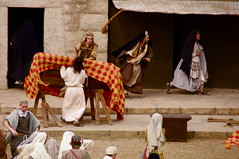I intend to demonstrate in a series of posts that there is legitimate room for informed, rational, scholarly debate over the historicity of certain events in the so-called life of Jesus. To disagree with E. P. Sanders and “mainstream scholarly opinion” is by no means to be equated with failing to engage the views and arguments of E. P. Sanders and other scholars sharing a majority viewpoint.
Yet public intellectuals from the field of biblical studies have disgraced themselves by declaring that if so-called “mythicists” disagree with the conclusions of the likes of E.P. Sanders and “the mainstream” they are comparable to “Young Earth Creationists”. (It is Intelligent Design advocates who misrepresent their opponents’ arguments and fail to engage directly with the substantial thrust of the literature they oppose, while “mythicists” do indeed engage seriously and with “mainstream literature”, while “historicists” have tended to remain apparently lazily ignorant and willing to distort and misrepresent mythicist arguments. So if the insulting comparison is to be made at all, it would seem to apply more to the “historicists” than to “mythicists”.) Associate Professor James McGrath inferred that the arguments of E.P. Sanders in chapter 1 of his book, Jesus and Judaism, are of sufficient strength and repute to justify ad hominem attacks on anyone who disagrees with the historicity they supposedly affirm. Hence this post as the first of a series.
Before beginning, for what it’s worth, I do not see myself as a “mythicist”. I cannot see the point of taking such a stand — either mythicist or historicist — in any debate. (I don’t like adversarial debates anyway. I’m more an exploration and testing type of guy.) What surely matters is the examination of the evidence in attempting to understand Christian origins. The point is to be as intellectually honest as we can wherever the evidence and out testing of our hypotheses lead.
E. P. Sanders on the historicity of the Temple Act of Jesus

I will not at this point address all the arguments of E. P. Sanders over what is more widely known as the “cleansing of the temple” scene. Most of his argument is, in effect, an analysis of various proposed reasons or motives for the temple act of Jesus. As such, it assumes the historicity of Jesus. To the extent that his argument does address historicity, Sanders is arguing that Jesus must have done something in relation to the temple, otherwise we are left with no explanation for his subsequent arrest and crucifixion. I see this sort of analysis as an exercise in the exposition of a literary narrative. It is misguided to assume without external supporting evidence that such an exercise necessarily yields up “evidence” of an “historical fact” external to that text. But for now, I will focus on the assumption of historicity per se, and not address each and every one of Sander’s “extremely common” ‘aprioristic’ points (i.e. ‘if Jesus did X, he must have done Y’) (p.9). I will reserve these for a future post when addressing Sander’s discussion of his method and the nature of a “good hypothesis”.
Sanders “establishes” the historicity of the Temple Act before commencing his attempt to explain its specific nature and motive. Indeed, it is its “indisputable” historicity that he claims is his justification for his chapter 1 discussion.
Sanders begins by noting the problems with gospel passages that narrate the temple incident (p. 9, my formatting):
- there is neither firm agreement about the unity and integrity of the basic passages concerning the ‘cleansing of the temple’
- nor is there absolute certainty of the authenticity of either or both of the sayings about the destruction of the temple.
Despite all this, it is overwhelmingly probable that Jesus did something in the temple and said something about its destruction. (p.9)
To justify his assertion that it is “overwhelmingly probable” that a real historical event lies behind the narratives, Sanders explains:
The accusation that Jesus threatened the temple is reflected in three other passages: the crucifixion scene (Matt. 27.39f.//Mark 15.29f.); Stephen’s speech (Acts 6.13f.); and with post-Easter interpretation, in John 2.18-22. The conflict over the temple seems deeply implanted in the tradition, and that there was such a conflict would seem to be indisputable. (p.9)
This is called in the literature an example of “multiple, independent attestation”. We have three sources (the synoptic gospels, Acts and John), all presumably independent of one another, saying something like the same thing. This, it is argued, strongly suggests that we have three independent witnesses to a tradition that must be traced back to something Jesus really did do or say.
Later, Sanders again writes (p. 73):
. . . the tradition contained in [John 2.19], Mark 14.58, Matt. 26.61, Mark 15.29, Matt. 27.40, and Acts 6.14: Jesus threatened the destruction of the temple (and perhaps predicted its rebuilding after three days).
We seem here to be in touch with a very firm historical tradition, but there is still uncertainty about precisely what it is.
I will unpack the assumption of the “tradition” as the common source below. For now, I will note only that it is by no means certain that the author of Acts who composed the speech of Stephen was unaware of the Gospel of Mark. Many scholars seem to think that this author also wrote Luke, and that he used Mark in composing his gospel. Nor is it certain that the author or redactor of the Gospel of John responsible for the temple incident in that gospel did not know Mark’s gospel. The common literary structure of the trial narrative in the two gospels is the most obvious point in common between the two. Overviews of modern scholarly discussions of the possibility of John’s knowledge of the synoptic gospels generally and Mark in particular can be found in D. Moody Smith’s John Among the Gospels, available in part online. See in particular chapter 6, The Dissolution of a Consensus.
So scarcely before we can begin a discussion of the historicity of the temple act, Sanders’ suggestion that we have three independent witnesses to a “tradition” is shown not to so secure if we let the discussions among “mainstream scholars” be our guiding reference point.
Paula Fredriksen’s on the “scholarly consensus” in relation to the Temple Act
Paula Fredriksen certainly accepts some form of temple act as historical, but also has the honesty to write:
In research on the historical Jesus, however, no single consensus interpretation ever commands 100 percent of the scholarly opinion. . . . Other critics, rightly observing the crucial role played by the Temple incident in Mark’s rendition of Jesus’ story — without it, Mark would have difficulty bringing Jesus to the attention of the priests — question whether it ever happened at all. Actual history rarely obliges narrative plotting so exactly: Perhaps the whole scene is Mark’s invention. (p. 210 of Jesus of Nazareth, King of the Jews – my emphasis)
Fredriksen is not ignorant of E. P. Sanders’ views. She cites Jesus and Judaism in her biography and makes frequent use of his ideas throughout her work. I suspect she is thinking in particular of Burton Mack when she writes: “Actual history rarely obliges narrative plotting so exactly: Perhaps the whole scene is Mark’s invention.” Mack’s A Myth of Innocence is also listed in her biography.
Burton Mack’s’ argument for the Temple Act being fiction
The act itself is contrived. Some gesture was required that could symbolize both casting out and taking charge with some level of legitimacy.
Demons would be too much, since Jesus is about to be taken. It would, in any case, have been implausible. But filthy lucre would do just fine. Taxes and the temple treasury had been hot political issues underlying much of the history of conflict between Jerusalem and Rome. The citations from Isaiah and Jeremiah could put Jesus on the safe side of the conflict, motivated by righteous indignation. Jewish authorities (scripture) could be used against Jewish practice. The subtheme of temple robbery, moreover, given with the citation from Jeremiah, was also most convenient. Temple robbery was a stock image of temple degredation in the popular imagination, combining criminal activity with impiety.
The first use of the theme in Mark is Jesus’ application of Jeremiah’s charge to those who brought and sold in the temple (that is, animals for offerings and money at foreign rates of exchange). This subtheme occurs at the arrest where Jesus chides the arresters coming after him as though he, not the money changers, were the temple robber (Mark 14:48). This develops the theme somewhat, playing on the symbolic significance of the temple act and putting the countercharge in his opponent’s mouth. At the trial the question of Jesus’ authority is the more important theme, but the temple act has not been forgotten. Jesus’ authority is related to the kingdom, the substitute for the temple, thus builds (sic) upon the temple act as symbolically having taken charge. The hearsay about destroying the temple pushes the symbolism of the act in the direction of an exorcism (casting out as destroying). And underlying the charge of blasphemy is desecration, also related allusively to the temple act. When Jesus is crucified then, he is positioned between two robbers, that is, as one who desecrated the temple (Mark 15:27). Thus the subtheme is carried through to the end. It is a fictional theme derived from the scriptural citations.
The temple act cannot be historical. If one deletes from the story those themes essential to the Markan plots, there is nothing left over for historical reminiscence. The anti-temple theme is clearly Markan and the reasons for it can be clearly explained. The lack of any evidence for an anti-temple attitude in the Jesus and Christ traditions prior to Mark fits with the incredible lack of incidence in the story itself. Nothing happens. Even the chief priests overhear his “instruction” and do nothing. The conclusion must be that the temple act is a Markan fabrication. (pp. 291-292, my emphasis. I have also broken up the first paragraph into three parts for easier web-reading.)
(Mack’s statement, “If one deletes from the story those themes essential to the Markan plots, there is nothing left over for historical reminiscence”, addresses a point too rarely absent from “historicist” discussions about Jesus. Remove the scriptural embellishments and other plot devices and there is no ‘person’ left for history to see. This is why it is fallacious to claim that, since mythical associations do not discredit the historicity of ancient characters like Alexander or the Caesars, so therefore they should not discredit the historicity of Jesus. This argument misses the point: remove the mythical associations from Alexander and the Caesars and there is still plenty of ‘historical person’ left over to see. This is not the case with Jesus. But I am addressing here the correct logic of Mack’s argument. Mack himself accepts that there was an historical Jesus. One wonders, however, how Fredriksen or other “mainstream scholars” might have reacted if it had been a “mythicist” who expressed the above argument.)
The Origin of the story: Historical Tradition or Textual Tradition?
Continue reading “Why the Temple Act of Jesus is almost certainly not historical”




